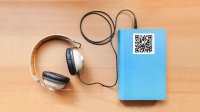Using QR Codes to Build a Classroom Audio Library
QR codes can be used to turn the books in your class library into audiobooks, which can help guide your students to their personal literacy goals.
Your content has been saved!
Go to My Saved Content.We know that children of all ages not only enjoy being read to, but need it. Because of this, teachers at my school carefully construct our literacy blocks to maximize the amount of time spent in shared reading and writing experiences throughout the day.
In addition to participating in whole-group shared reading lessons, students need to work independently toward personal literacy goals. One way that we differentiate instruction and guide students toward meeting their goals is through the use of listening centers. Listening centers create a more versatile and enriching experience by allowing students to choose a book of interest and listen to the recorded narration as they follow along in the text.
The benefits of audiobooks in the classroom are appreciated by all teachers; however, purchasing compact discs or cassettes with paired texts is expensive. Online subscriptions to reading websites are also pricey and don’t allow students to hold a physical text in their hands, a necessity for emergent readers developing their vocabulary and concepts of print. Additionally, providing an assortment of high-quality audiobooks that will engage a wide range of student abilities and interests is nearly impossible.
One solution to this problem lies in the versatility of the Quick Response (QR) code. Using audio QR codes creatively can open a gateway in your classroom to a remarkably targeted level of instruction.
Audio QR codes can make books speak to your students. All you need to do is record yourself (or someone else) reading a book, link the audio file to a QR code, and attach the code to the book cover, and you’ve created an instant audiobook. No more pricey CDs and paired texts. No more expensive subscriptions to reading websites. Using only your smartphone and computer, you can transform every book in your classroom library into an audiobook. It is so simple and yet so powerful.
Get Your Audio Library Up and Running
Many hands make light work, so gather as many readers as you can. Recruit class parents to record a few texts. Bonus: Your students will love discovering which members of their families and their classmates’ families have contributed to their classroom library.
Make it a service-learning opportunity: Enlist the help of high school students, who are often in need of community service hours.
Get your colleagues in on the action by sharing a Google Sheets master list with your fellow teachers, and they can search for books that they have in their libraries that already have a QR code available. They can also contribute to the list themselves.
You may need to educate parents about your audiobook library. It may appear to some parents that their child is not actually reading. Sending home a bulletin explaining your project will help them understand the intentions of your project while highlighting the educational value.
Maximize the Effectiveness of Your QR Audio Library
Audiobooks can be used to promote an interest in reading and to model reading prosody. They offer the reader an opportunity to improve sight word vocabulary and increase reading fluency. Remember to always encourage students to read along while tracking the text with a tracking tool or their finger.
Locate and record books that relate to the unique interests of your students. Use this opportunity to get your students hooked on a great author or series or to learn more about a particular topic of interest.
Create book clubs. Allow students to listen to a grade-level book so that they can engage in discussions about the text with their peers.
And finally, encourage at-home reading by allowing students to bring home a few audiobooks to read and listen to with their families.
Audiobooks for the Average/Gifted Student
The evidence supporting the use of audiobooks for struggling readers, nonreaders, the learning disabled, and English as a Second Language students is abundant. However, many educators miss an important opportunity for student growth when they fail to consider the benefits that audiobooks can provide for their average, avid, and gifted readers.
Introduce students to books above their reading level. For example, consider a second-grade student who may have a high interest in a novel but may not otherwise have access (e.g., a parent who can read to them at home). You can bridge that gap with an audiobook.
Teach critical listening. The Common Core State Standards place a heavy emphasis on speaking and listening skills. Starting in kindergarten, students are prompted to ask questions and make connections between texts. You can provide an authentic and practical application of this skill for all of your students with an audiobook paired with targeted questions.
Introduce new genres that students might not otherwise consider. One advantage to creating your own audiobooks is the unique opportunity to provide an introduction or commentary on the text. By creating a separate batch of QR codes with book reviews, you can generate interest in a new genre by having the students scan and listen to the codes during independent reading time.
Given the many benefits, it’s well worth your time to set up a class audiobook library.
- Watch a tutorial on creating and uploading an audio file using Voice Memo.
- Watch a tutorial on generating a QR code using Google Sheets.
- Use this template to create your own Google Sheet with a QR Code Generator.
Note: Only works in the public domain may be made into audiobooks in this way. For works that are not in the public domain, you must seek permission from the copyright holder. An earlier version of this story referred to recording the Harry Potter books; doing so would require prior approval of the publisher.
